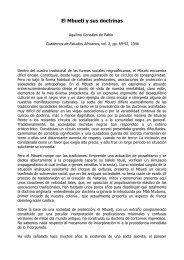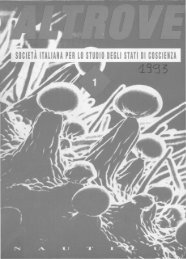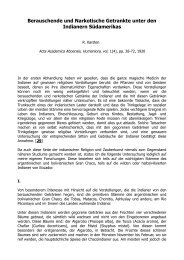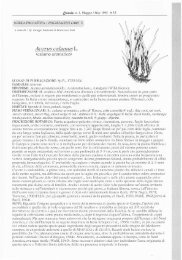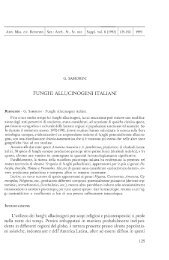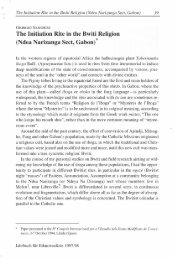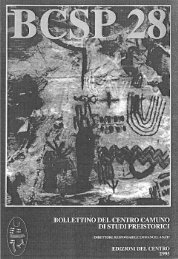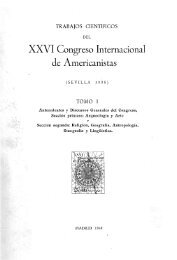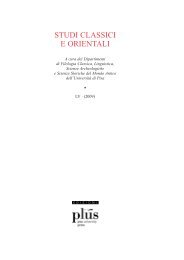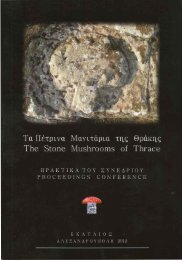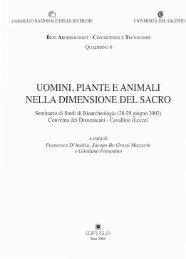Gli "alberi-fungo" nell'arte cristiana - Giorgio Samorini Network
Gli "alberi-fungo" nell'arte cristiana - Giorgio Samorini Network
Gli "alberi-fungo" nell'arte cristiana - Giorgio Samorini Network
You also want an ePaper? Increase the reach of your titles
YUMPU automatically turns print PDFs into web optimized ePapers that Google loves.
GIORGIO SAM ORINI<br />
106 Eleusis, n.s. , n. 1, 1998<br />
cosiddetta "Cripta degli Scavi", datato al 314 d.C. (cfr.<br />
MARINI 1994). Fra i diversi soggetti raffigurati nel mosaico<br />
- animali, croci, simboli geometrici - si riconosce un canestro<br />
contenente dei funghi<br />
(Fig. 26). In questo caso<br />
non si tratta di <strong>alberi</strong>fungo,<br />
bensì di veri e propri<br />
funghi, intenzionalmente<br />
rappresentati come tali<br />
dall'artista. Questo reperto<br />
parrebbe essere l'unico<br />
documento sinora a noi<br />
noto di un'evidente raffigurazione<br />
di funghi in una<br />
chiesa <strong>cristiana</strong> antica.<br />
Circa la specie di<br />
fungo che si è voluto rappresentare,<br />
Fabbro non<br />
mostra avere dubbi, identificandola<br />
con l'agarico<br />
date of the evident representation of mushrooms in an early<br />
Christian church.<br />
Fabbro appears to have no doubts as to the species of<br />
mushroom presented: flyagarico<br />
Indeed, he is<br />
perhaps too self-assured<br />
and hasty in his conclusion<br />
that this Aquileia<br />
"find" provides corroborative<br />
evidence that the early<br />
Christians used fly-agaric.<br />
As Francesco Festi of the<br />
Museo Civico in Rovereto<br />
and I concluded (FESTI &<br />
SAMORINI 1997), the<br />
mushrooms represented in<br />
the Aquileia mosaic were<br />
probably Amanita caesarea<br />
, also known as "ovulo<br />
buono " (royal-agaric), an<br />
muscario. Anzi, in una Fig. 26 - Particolare del mosaico della "Cripta degli Scavi" edible mushroom considedella<br />
Basilicil diAquileia. 314 d.C.<br />
maniera forse eccessiva-<br />
red a delicacy by the<br />
Mosaic ollhe "Cripta degli Scavi" fi vm /he Basilica 01Aquileia (de/ail). 314 AD<br />
mente sicura e frettolosa,<br />
ancient Romans and often<br />
vede nel documento di<br />
Aquileia una conferma dell'uso di questo fungo presso le<br />
antiche comunità cristiane.<br />
In un primo commento all'articolo di Fabbro,<br />
Francesco Festi, del Museo Civico di Rovereto, e chi scrive<br />
(FESTI & SAMORINI 1997), abbiamo espresso il parere che i .<br />
funghi rappresentati nel mosaico di Aquileia sono della<br />
specie Amanita caesarea, o "ovulo buono", fungo edule<br />
prelibato, ricercato dagli antichi Romani e comunemente<br />
raffigurato nell' arte romana imperiale. A riprova di ciò,<br />
abbiamo sottolineato il fatto che i gambi dei funghi sono<br />
colorati di giallo e non di bianco, una nota caratteristica<br />
distintiva fra le due specie. Tuttavia, in seguito a una mia<br />
visita sul luogo, ho potuto osservare che il colore della<br />
parte del mosaico che corrisponde alla parte interna dei<br />
cappelli dei funghi, cioè alle loro lamelle, è di colore bianco,<br />
come nell'agarico muscario, e non giallo come è nell'ovulo<br />
buono. Anzi, mentre è impossibile incontrare in natura<br />
ovuli buoni con le lamelle di un colore differente dal giallo,<br />
in alcuni casi le lamelle e il gambo del!' agarico muscario<br />
possono presentare tonalità di colore giallo (ARIETII &<br />
TOMASI 1975: 106). Verificato che l'artista del mosaico ha<br />
predisposto serie di tasselli scuri per delimitare le varie<br />
aree da riempire con tasselli di differenti colori, escludendo<br />
con ciò la possibilità di confondere parti diverse del fungo<br />
riempite con tasselli del medesimo colore, appare chiaro<br />
ch' egli intese raffigurare le lamelle proprio di colore bianco<br />
e non di un altro colore, un fatto tale da porre seri dubbi<br />
circa l'identificazione di questi funghi come A. caesarea.<br />
Inoltre, un paio fra gli otto funghi rappresentati hanno<br />
gambi non totalmente di colore giallo, bensì bianchi e gialli.<br />
included in the figurative<br />
works of the Roman imperial periodo We based our view on<br />
the fact that the mushroom stalks are yellow and not white,<br />
this being one of the distinguishing marks between these<br />
two species. However, after paying a visit to the basilica I<br />
did note that the part of the mosaic corresponding to the<br />
inside of the caps, the gills, is white, as are the gills of the<br />
fly-agaric, and not yellow (as in the royal-agaric).<br />
Furthermore, while the gills of the royal-agaric are always<br />
yellow, in some cases the gills and stalk of fly-agaric present<br />
gradations of yellow (ARIETII & TOMASI 1975: 106). It<br />
was also noted that the artist had circumscribed the various<br />
areas of the mosaic to be filled in with different colours<br />
with dark-coloured fragments, which means that the wrong<br />
colour of fragment would not be able to make its way into<br />
another circumscribed zone of another colour. Therefore<br />
we may conclude that the artist wished to portray these<br />
mushrooms specifically with white gills, and that there is<br />
good reason to doubt that these mushrooms are in fact A.<br />
caesarea. Another feature of this mosaic is that two of the<br />
eight mushrooms have stalks which are not entirely yellow<br />
but also white.<br />
The Aquileia mushrooms would therefore appear not<br />
to be explicitly represented as belonging either to the fly or<br />
the royal agaric species. Representation of the royal agaric<br />
would not call for subterfuge, but fly agaric would.<br />
However, this may be yet another species of mushroom or<br />
quite simply a generi c "mushroom". It has been hypothesized<br />
that the mosaic represents the food (including mushrooms)<br />
the faithful consumed during agapes (mysterious<br />
ritual feasts held by early Christians) (Brusin & Zovatto<br />
1957, cito in FABBRO 1996).<br />
Quindi, nei funghi del mosaico di Aquileia non



